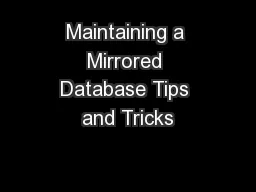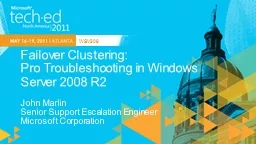PPT-Stretching failover clusters and using storage replica in w
Author : tatyana-admore | Published Date : 2016-07-02
Elden Christensen amp Ned Pyle Program Managers Windows Server High Availability amp Storage BRK3487 Session Objective Understand how to stretch a Window Server
Presentation Embed Code
Download Presentation
Download Presentation The PPT/PDF document "Stretching failover clusters and using s..." is the property of its rightful owner. Permission is granted to download and print the materials on this website for personal, non-commercial use only, and to display it on your personal computer provided you do not modify the materials and that you retain all copyright notices contained in the materials. By downloading content from our website, you accept the terms of this agreement.
Stretching failover clusters and using storage replica in w: Transcript
Download Rules Of Document
"Stretching failover clusters and using storage replica in w"The content belongs to its owner. You may download and print it for personal use, without modification, and keep all copyright notices. By downloading, you agree to these terms.
Related Documents














